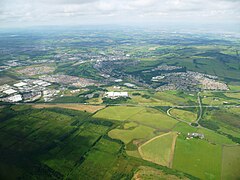
Back باثغيت Arabic باثجيت ARZ بسقیت AZB Bathgate Catalan Bathgate CEB Bathgate Welsh Bathgate German Bathgate Spanish Bathgate Basque بسگیت Persian
Bathgate
| |
|---|---|
 View of Bathgate, West Lothian from an aeroplane approaching Edinburgh Airport | |
Location within West Lothian | |
| Population | 23,600 (2022)[1] |
| OS grid reference | NS973689 |
| • Edinburgh | 18 mi (29 km) |
| • London | 336 mi (541 km) |
| Council area | |
| Lieutenancy area |
|
| Country | Scotland |
| Sovereign state | United Kingdom |
| Post town | BATHGATE |
| Postcode district | EH47, EH48 |
| Dialling code | 01506 |
| Police | Scotland |
| Fire | Scottish |
| Ambulance | Scottish |
| UK Parliament | |
| Scottish Parliament | |
Bathgate (Scots: Bathket or Bathkit,[2] Scottish Gaelic: Both Chèit)[3] is a town in West Lothian, Scotland, 5 miles (8 km) west of Livingston and adjacent to the M8 motorway. Nearby towns are Linlithgow, Livingston, and West Calder. A number of villages fall under the umbrella of Bathgate, including Blackburn, Whitburn, Stoneyburn, Armadale,Torphichen and Fauldhouse.
Situated 2 miles (3 km) south of the ancient Neolithic burial site at Cairnpapple Hill, Bathgate and the surrounding area show signs of habitation since about 3500 BC and the world's oldest known reptile fossil has been found in the town. By the 12th century, Bathgate was a small settlement, with a church at Kirkton and a castle south of the present day town centre. Local mines were established in the 17th century but the town remained small in size until the coming of the industrial revolution. By the Victorian era, Bathgate grew in prominence as an industrial and mining centre, principally associated with the coal and shale oil industries. By the early 20th century, much of the mining and heavy industry around the town had ceased and the town developed manufacturing industries, principally in vehicle production and later electronics before these factories closed in the late 20th century.
Today Bathgate is the second largest town in West Lothian, after Livingston and serves as a regional commuter town within the Scottish Central Belt.
- ^ "Mid-2020 Population Estimates for Settlements and Localities in Scotland". National Records of Scotland. 31 March 2022. Retrieved 31 March 2022.
- ^ "The Online Scots Dictionary". Archived from the original on 11 January 2015. Retrieved 5 September 2012.
- ^ List of railway station names in English, Scots and Gaelic Archived 22 January 2013 at the Wayback Machine – NewsNetScotland
